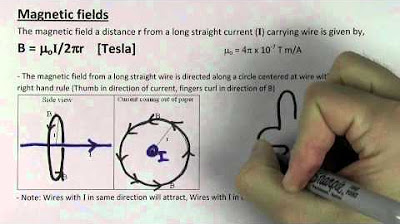Induction - An Introduction: Crash Course Physics #34
TLDRThis episode of Crash Course Physics explains how physicists in the 19th century discovered that changing magnetic fields can induce electric currents. Joseph Henry and Michael Faraday showed that while constant magnetic fields do not create currents, changing magnetic fields do through the concept of magnetic flux. The induced current flows in a direction that opposes the change in magnetic flux, as described by Lenz's law. The episode further explains how to calculate the induced emf and apply these principles to understand hard drives. Overall, it provides a foundational explanation of induction and its applications.
Takeaways
- 😲 Magnetic fields can induce electric currents, but only when the magnetic field is changing over time
- 😃 Faraday discovered that changing magnetic fields over time induce electric currents in nearby conductors
- 📏 The key property that determines induced EMF is magnetic flux - the magnetic field passing through a surface
- 📈 Changes in magnetic flux over time induce an EMF, creating a current
- 🤓 There are 3 factors that affect magnetic flux: magnetic field strength, conductor area, conductor angle
- 🔀 Lenz's law states that the induced current will create a magnetic field that opposes the change causing it
- ✅ You can use the right hand rule to determine the direction of the induced current
- 🖥 Hard drives store data by magnetizing sections of a rotating disk, then reading the data via electromagnetic induction
- 🤯 Moving a conductor in and out of a magnetic field also induces a current, with EMF proportional to velocity
- 💡 Induced currents are useful for generators, transformers, motors, hard drives, and more
Q & A
What did physicists discover about electric currents and magnetic fields in the 19th century?
-Physicists discovered that electric currents can create magnetic fields.
What did scientists wonder after discovering that electric currents can create magnetic fields?
-Scientists wondered if the opposite was also true - if magnetic fields could create or induce electric currents.
Why did early experiments trying to detect electric currents induced by magnetic fields keep failing?
-The early experiments kept failing because the magnetic fields were not changing over time. Only a changing magnetic field induces an electric current.
What is Faraday's Law of Induction?
-Faraday's Law of Induction states that a changing magnetic field will induce an electromotive force (EMF) in a loop of wire.
What three factors affect the magnetic flux through a loop of wire?
-The three factors that affect magnetic flux through a loop are: the strength of the magnetic field (B), the area of the loop (A), and the angle (theta) between the magnetic field and a line perpendicular to the loop.
How is the direction of the induced electric current determined?
-Lenz's Law states that the induced current will generate a magnetic field to oppose the change in original magnetic flux. Using the right-hand rule on this opposing magnetic field gives the direction of the induced current.
How is an EMF induced when moving a loop of wire in and out of a magnetic field?
-The induced EMF is equal to the magnetic field strength times the length of the wire loop times the velocity of the loop.
How do hard drives use magnetic induction?
-Hard drives magnetize small sections of a rotating disk to store data. As the disk rotates, the changing magnetic fields induce currents in an electromagnet coil, which is processed as computer data.
What happens when magnetic flux through a coil changes?
-A changing magnetic flux will induce an EMF in the coil. The total EMF depends on the number of loops in the coil.
What causes a current to be induced in a loop of wire?
-A changing magnetic field through the loop causes induction. Specifically, it is the change in magnetic flux over time that induces the EMF and current.
Outlines
⚡️ Faraday's Law of Induction
This paragraph provides an overview of Faraday's experiments with electromagnetism. It explains that a constant magnetic field does not induce electric current in a wire loop, but a changing magnetic field does. The induced EMF is proportional to how quickly the magnetic field changes over time. Magnetic flux, which measures the magnetic field through a wire loop, is a key concept. The factors that influence magnetic flux are explained.
😀 Applying Lenz's Law
This paragraph explains Lenz's law and how to apply it to determine the direction of induced current. Using the example scenarios of moving a bar magnet toward or away from a wire loop, it demonstrates how to analyze the direction of the induced magnetic field. By applying the right-hand rule, the direction of the resulting current can then be determined.
Mindmap
Keywords
💡electric current
💡magnetic field
💡electromotive force (EMF)
💡magnetic flux
💡Faraday's Law
💡Lenz's Law
💡electromagnet
💡generator
💡hard drive
💡induction
Highlights
First significant research finding
Introduction of new theoretical model
Proposed innovative methodology for analysis
Key practical application and recommendations
Transcripts
Browse More Related Video

michael faraday | law of electromagnetic induction | faraday's law of induction

10. Ampere's Law

Lenz's Law, Right Hand Rule, Induced Current, Electromagnetic Induction - Physics

Magnetic (AP Physics SuperCram Review)

Faraday's Law of Electromagnetic Induction, Magnetic Flux & Induced EMF - Physics & Electromagnetism

Maxwell's Equations: Crash Course Physics #37
5.0 / 5 (0 votes)
Thanks for rating: